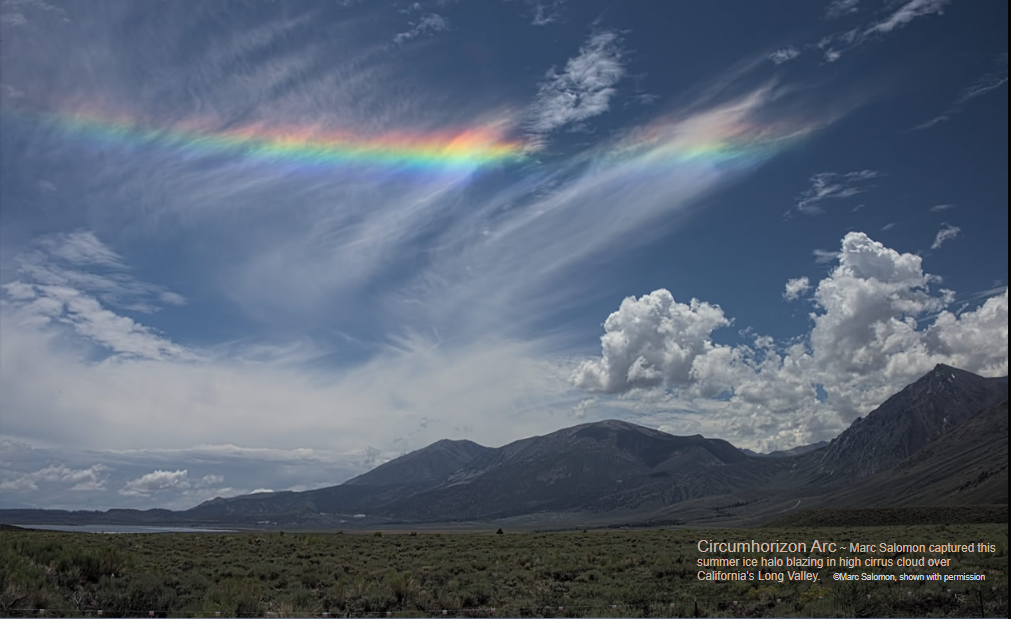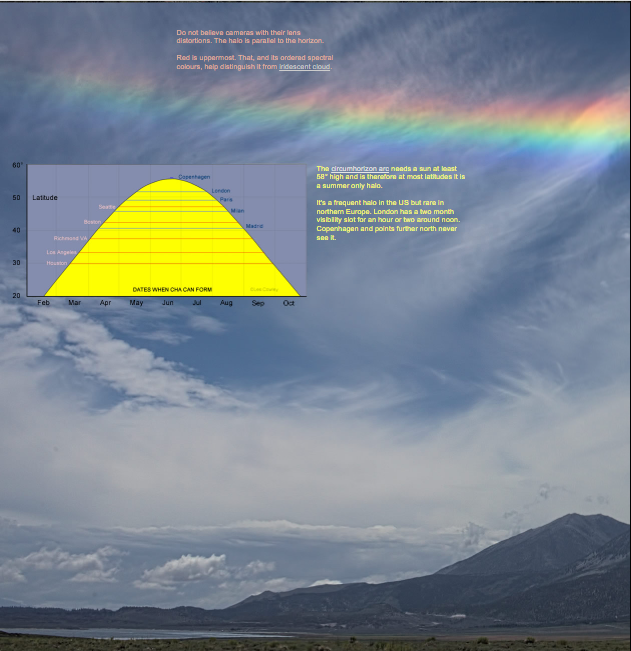Circumhorizon Arc, California - OPOD
Circumhorizon Arc: A Stunning Summer Halo Phenomenon
The Circumhorizon Arc is a breathtaking atmospheric optical phenomenon that occurs in high cirrus clouds during the summer months. This rare halo is often seen in the United States but is relatively uncommon in northern Europe. In this article, we will delve deeper into the fascinating details of the Circumhorizon Arc, exploring its characteristics, formation, and geographical distribution.
A Parallel Blaze of Colors
When observing the Circumhorizon Arc, one might be tempted to think that the camera lens has distorted the image. However, this phenomenon is indeed parallel to the horizon, forming a stunning blaze of colors in the sky. The uppermost color in the arc is red, which helps distinguish it from iridescent clouds. Additionally, the ordered spectral colors further enhance its distinctive appearance.
Conditions for Observation
To witness the Circumhorizon Arc, one must be in a location where the sun is at least 58° high in the sky. This means that in most latitudes, this halo can only be seen during the summer season. The specific angle of the sun's elevation is crucial for the arc to form and display its vibrant colors. It is important to note that the visibility of this phenomenon varies depending on geographical location.
Geographical Distribution
The Circumhorizon Arc is a frequent sight in the United States, captivating observers with its ethereal beauty. However, its occurrence is much rarer in northern Europe. For instance, London provides a two-month window of visibility for an hour or two around noon. On the other hand, cities like Copenhagen and locations further north never have the opportunity to witness this mesmerizing halo.
Formation Mechanism
The formation of the Circumhorizon Arc involves a complex interplay between sunlight and ice crystals within cirrus clouds. As sunlight passes through these hexagonal ice crystals, it undergoes refraction, resulting in the separation of its spectral colors. This dispersion creates the stunning array of hues that make up the arc. The specific alignment and orientation of the ice crystals play a crucial role in determining the shape and position of the halo.
Similarities to Other Halos
The Circumhorizon Arc shares similarities with other halo phenomena, such as the more commonly observed 22° halo. Both halos are formed through the refraction and dispersion of sunlight by ice crystals. However, what sets the Circumhorizon Arc apart is its unique position in the sky, parallel to the horizon. This distinct orientation adds to its allure and sets it apart from other halos.
The Beauty of Nature's Optics
Witnessing the Circumhorizon Arc is truly a remarkable experience, showcasing the captivating beauty and complexity of atmospheric optics. The vibrant colors and parallel alignment of this halo create a spectacle that leaves observers in awe of nature's wonders. Whether capturing it on camera or experiencing it firsthand, the Circumhorizon Arc is a testament to the intricacies and marvels of our atmosphere.
In conclusion, the Circumhorizon Arc is a breathtaking atmospheric optical phenomenon that occurs in high cirrus clouds during the summer months. Its parallel alignment to the horizon, vibrant colors, and unique geographical distribution make it a sight to behold. Understanding the formation mechanisms behind this halo deepens our appreciation for the intricate interplay between sunlight and ice crystals in our atmosphere. So, keep your eyes to the sky during those summer months and you might just catch a glimpse of this mesmerizing display of nature's artistry.

Circumhorizon Arc ~ Marc Salomon captured this summer ice halo blazing in high cirrus cloud over California's Long Valley. ©Marc Salomon, shown with permission

Do not believe cameras with their lens distortions. The halo is parallel to the horizon.
Red is uppermost. That, and its ordered spectral colours, help distinguish it from iridescent cloud.
The circumhorizon arc needs a sun at least 58° high and is therefore at most latitudes it is a summer only halo.
It's a frequent halo in the US but rare in northern Europe. London has a two month visibility slot for an hour or two around noon. Copenhagen and points further north never see it.
Note: this article has been automatically converted from the old site and may not appear as intended. You can find the original article here.
Reference Atmospheric Optics
If you use any of the definitions, information, or data presented on Atmospheric Optics, please copy the link or reference below to properly credit us as the reference source. Thank you!
-
<a href="https://atoptics.co.uk/blog/circumhorizon-arc-california-opod/">Circumhorizon Arc, California - OPOD</a>
-
"Circumhorizon Arc, California - OPOD". Atmospheric Optics. Accessed on November 26, 2024. https://atoptics.co.uk/blog/circumhorizon-arc-california-opod/.
-
"Circumhorizon Arc, California - OPOD". Atmospheric Optics, https://atoptics.co.uk/blog/circumhorizon-arc-california-opod/. Accessed 26 November, 2024
-
Circumhorizon Arc, California - OPOD. Atmospheric Optics. Retrieved from https://atoptics.co.uk/blog/circumhorizon-arc-california-opod/.